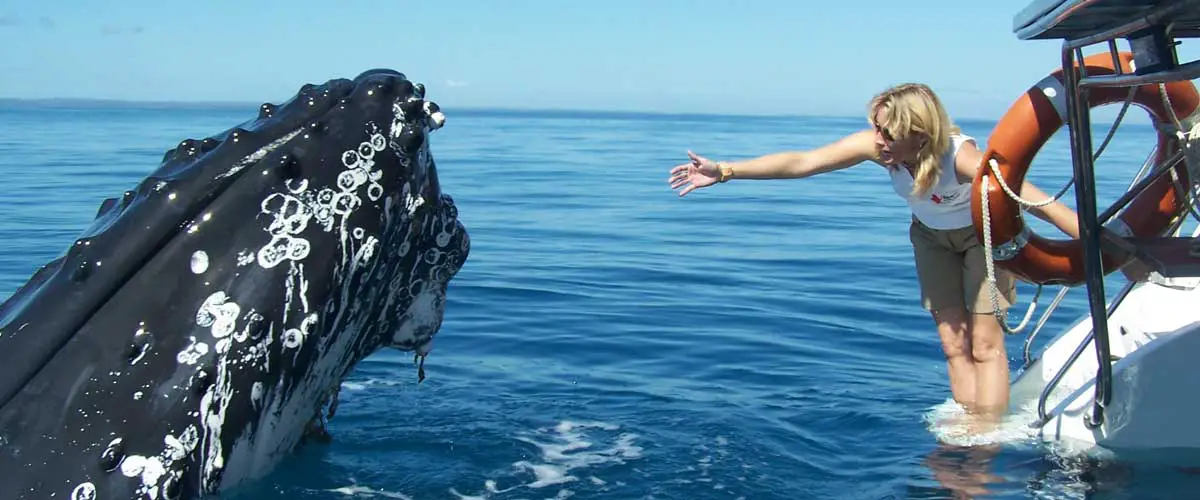Found in oceans and seas around the world, humpback whales typically migrate up to 25,000 kilometres each year, and it is during that migration that they are seen in Australian waters. Humpbacks feed only in summer, in polar waters, and migrate to tropical or sub-tropical waters to breed and give birth in the winter. During the winter, humpbacks fast and live off their fat reserves. The species’ diet consists mostly of krill and small fish.
Once hunted to the brink of extinction, humpbacks are now sought by whale-watchers, particularly off parts of Australia, Canada, and the United States.
The Southern Right Whale is a baleen whale, one of three species classified as right whales belonging to the genus Eubalaena. Around 12,000 Southern Right Whales are spread throughout the southern part of the Southern Hemisphere.
Like other right whales, the Southern Right Whale is readily distinguished from other whales by the callosities on its head, a broad back without a dorsal fin, and a long arching mouth that begins above the eye. The body of the whale is very dark grey or black, occasionally with some white patches on the belly. The right whale’s callosities appear white, not due to skin pigmentation, but to large colonies of cyamids or whale lice. The Southern Right Whale spends the summer months in the far Southern Ocean feeding, probably close to Antarctica. It migrates north in winter for breeding and can be seen around the coasts of Argentina, Australia, Brazil, Chile, Namibia, Mozambique, Peru, Uruguay, Madagascar, New Zealand and South Africa.
In Australia’s winter and spring, Southern Right Whales can be seen from the Bunda Cliffs and Twin Rocks, both along the remote Great Australian Bight in South Australia. In Warrnambool, Vic, there exists a nursery near Logan Beach which is a popular tourist attraction.
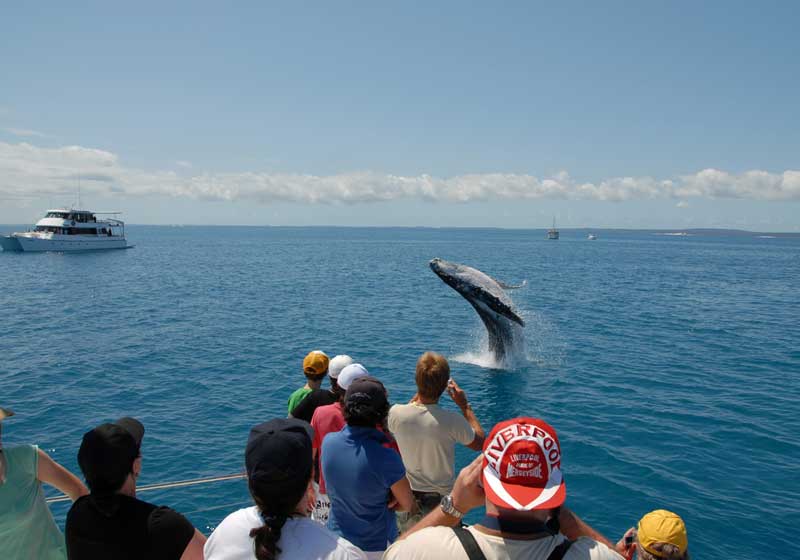
Whale watching, Hervey Bay, Qld
Australia is one of the best whale watching locations in the world. With whale watching operators springing up all along the coastline, viewing the magnificent creatures in their natural habitat is easy. From late July to early November, the majestic Humpback Whales can be seen as they migrate from cool southern waters around Antarctica to more temperate, sub-tropical waters to give birth. The International Fund for Animal Welfare found 1.5 million people went whale watching in Australia last year.
The three most common whales seen in Australian waters are the Humpback, Southern Right and Orca (Killer) Whales. Humpback and Southern Right whales follow a similar route each year.
Southern right whales are characterized by their uniformly dark colour and white callosities found on and around the head. Callosities, which are outgrowths of tough skin, are often used in identifying individual whales, as they are unique to each animal, similar to fingerprints in humans. The largest of these excrescences (callosities) is located on the anterior-most portion of the head and is referred to as the “bonnet.” Other excrescences are on the upper edge of the lower jaw, behind the blowhole, and above the eye.
Eubalaena australis is on average between 16 and 18 meters long at maturity, males being slightly shorter than females. It has a rotund appearance, a very large girth relative to the length, with an enormous head (approximately 1/3 the body length). Southern right whales do not have any dorsal fins, nor do they have the grooved throat that is typical of the balaenopterids. The flippers are also broad and relatively short. Another distinguishing physical feature of southern right whales is the blowhole. The exterior of the blow hole is well-partitioned, resulting in a V-shaped exhaust of condensation and water vapour. Furthermore, uncharacteristic of balaenopterids, southern right whales have a well-developed dermis without fat, whereas most balaenopterids lack a dermis.
The most distinctive external features of humpbacks are the flipper size and form, fluke coloration and shape, and dorsal fin shape. Flippers are quite long and can be almost a third of the body length. They are largely white and have knobs on the leading edge. The butterfly-shaped tail flukes bear individually distinctive patterns of gray and white, and have a scalloped trailing edge. The dorsal fin can be a small triangle or sharply falcate, and often has a stepped or humped shape; this is one source of the name “humpback.”
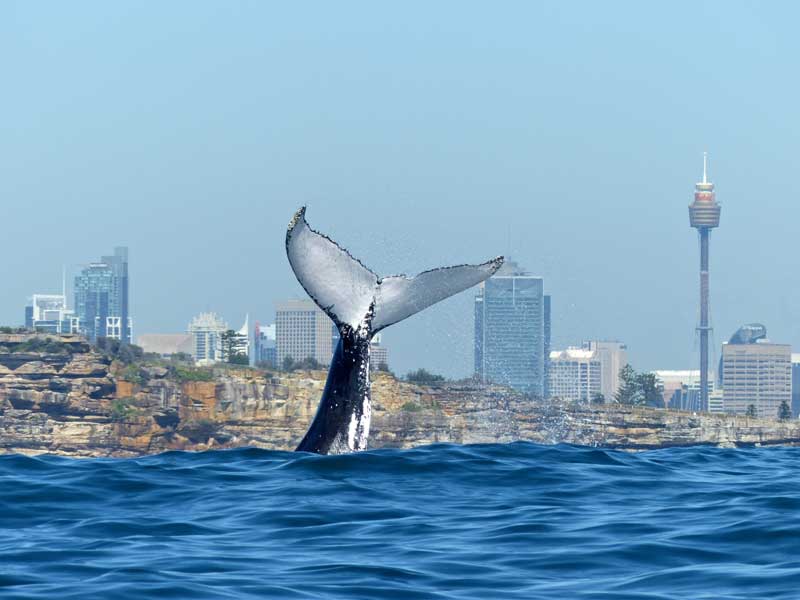
Humpback Whale off Sydney, NSW
Southern right whales migrate to the southern latitudes of their range during the summer months where plankton populations are more abundant, and migrate north during winter and spring.
They do so at a rate of 2.7 to 4.2 km/hr over a 24-hour period for cow and calf pairs. In addition, Eubalaena australis have been observed at near-shore swimming speeds of up to 15+ km/hr (for only short distances), but are generally slow swimmers.
In a common behaviour among these whales, called “headstanding”, they assume a vertical position and extend the flukes into the air, often rocking back and forth, for as long as two minutes at a time. Research initially indicated that this position was used for feeding on benthic organisms, however is more recently believed to be either a resting position or a courtship stimulus. Southern right whales are also commonly seen breeching – turning in midair and falling into the water with the side or back of the body. This behaviour may dislodge parasites from the whale’s surface, but is also a display mechanism during mating.
Although very rarely found stranded along beaches, southern right whales occasionally do cause harm to themselves and, indirectly, humans. They have collided with large vessels and entangled in fishing gear. This causes a loss or reduction of possible shipping routes (in order to avoid collisions) and an increased cost to the fishing industry.
Humpback whales live in groups. They migrate seasonally from the tropics to the northern feeding grounds. In the tropics, they are found in dense aggregations on shallow banks. They are usually deep oceanic migrators between their feeding and breeding grounds; the vast majority of humpbacks do not come into coastal waters until they are ready to breed.
Breeding usually takes place once every two years, but it may occur twice every three years. Migration is largely connected with the two functions of feeding and reproduction. Pairing and mating take place in the warmer waters. Calves are born in the warm tropical waters and subtropical waters of each hemisphere. Newborns are usually 4 to 5 m long, and are suckled by their mothers for about 5 months. The females’ milk is highly nutritive, containing high amounts of fat, protein, lactose and water. There is no parental investment on the part of the males.
There is no direct evidence of territoriality. However, there are some types of preferred area sentiments by individuals or groups. This is supported by the seasonal returns to the same feeding and breeding grounds of most humpbacks.
Swimming speed may reach 27 km per hour and during migration, it may reach 3.8 to 14.3 km per hour. Whales with calves swim the slowest, whereas lone whales travel faster than those in groups. Humpbacks dive 6 to 7 m for 15 to 20 minutes. During diving, blows are not regular and flukes are not lifted as the whale submerges. In longer dives, the flukes are lifted and the animal surfaces between dives for about 4 minutes, while blowing regularly.
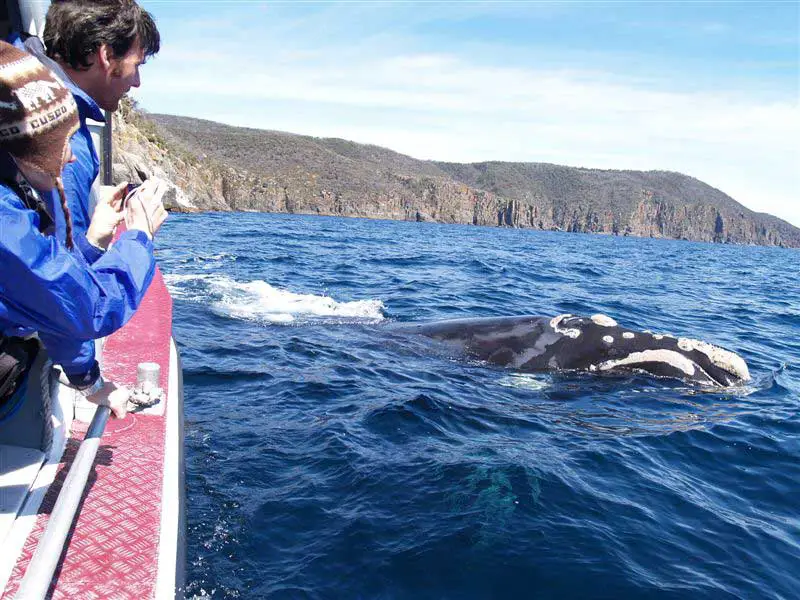
Whale off the Tasman Peninsula, Tasmania
Humpback whales live in polar and tropical waters, particularly those of the Atlantic, Arctic, and Pacific Oceans. The habitat of humpback whales consists of polar to tropical waters, including the waters of the Aortic and Atlantic Oceans in the northern hemisphere, and Pacific Ocean in the south, as well as the waters surrounding Antarctica. During migration, they are found in coastal and deep oceanic waters.
Australia’s humpback whale population is increasing but is still far behind estimated pre-whaling numbers. Humpback whales were almost extinct along the east coast of Australia when whaling ceased in Australia in 1963, with only about 200 to 500 whales left. SCU estimates the humpback whale population is now around 5000, well below the estimated pre-whaling population of 15,000 to 30,000.
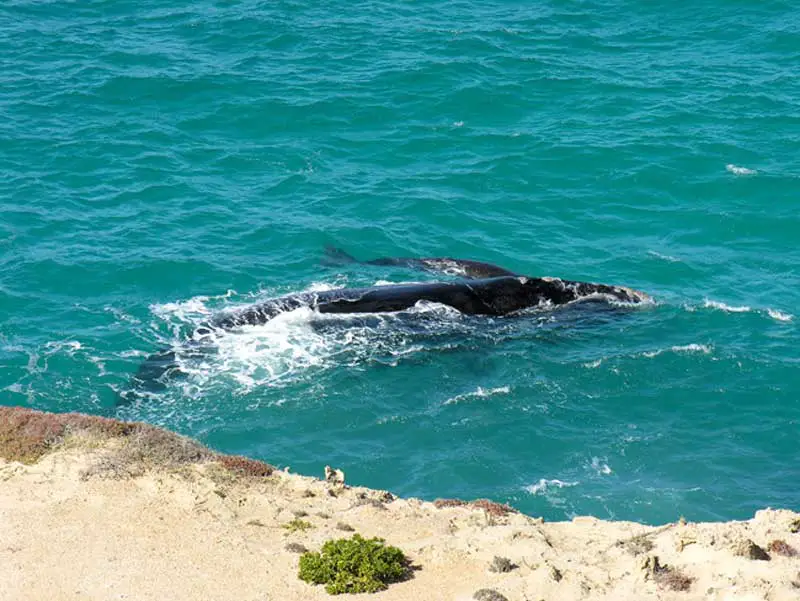
Mother and calf near Ceduna, SA
Humpbacks have historically had incredible economic importance to humans. They were one of the nine species hunted intensively by whalers. They were at times the most important constituent of the catch of modern whalers. Their oil was in demand as a kind of burning oil for lamps and as a lubricant for machinery. Whale oil was also used as a raw material for margarine and as a component of cooking fat. Whale meat was processed for human consumption and made into animal feed. Meal made from whale bones was used as fertilizer.
However, these animals are no longer hunted extensively. They do continue to have some economic impact, as eco-tourism and whale sighting tours are quite popular in appropriate coastal areas. Currently, there are an estimated 6,000 humpbacks in the earth’s waters, with possibly 1,000 to 3,000 more.
Humpback whales received some protection in 1985 when the International Whaling Commission instituted a moratorium on commercial whaling. In the early part of the twentieth century, during the modern whaling era, humpback whales were highly vulnerable due to their tendency to aggregate on the tropical breeding grounds and to come close to the shore on the northern feeding grounds.
In order to combat the problem of depletion, catching humpback whales was prohibited in the Antarctic in 1939, although that plan was abandoned in 1949. In the southern hemisphere, hunting was banned in 1963. In the North Atlantic, hunting was banned in 1956. Finally hunting was banned in the North Pacific in 1966.
Southern right whale populations are showing a slow increase since international protection in 1935, when over-exploitation nearly eradicated the species. There are estimated to be approximately 3,000 to 4,000 currently surviving in the southern hemisphere. Aside from international protection, individual countries are also protecting these whales and improving their ability to survive and reproduce.
For the past ten or fifteen years, humans have capitalized on southern right whales, as well as other whales and aquatic mammals. Currently, the increasing popularity of whale watching and coastal tourism has led to the whales having a positive economic impact on humans. The development of whale watching has promoted economic benefits to coastal communities while increasing the protection and awareness of the species – stressing the importance of environmental quality and conservation. This benefit to the whales and their habitat contrasts sharply with previous economic exploitation of southern right whales. They were extensively hunted for oil and meat before becoming protected.









